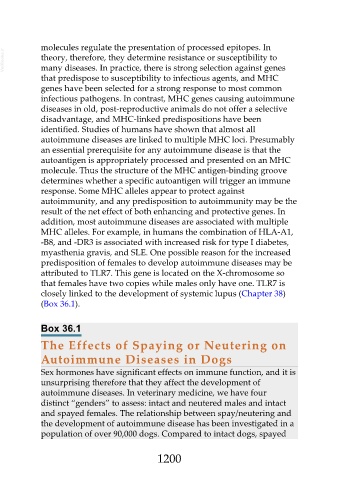Page 1200 - Veterinary Immunology, 10th Edition
P. 1200
molecules regulate the presentation of processed epitopes. In
VetBooks.ir theory, therefore, they determine resistance or susceptibility to
many diseases. In practice, there is strong selection against genes
that predispose to susceptibility to infectious agents, and MHC
genes have been selected for a strong response to most common
infectious pathogens. In contrast, MHC genes causing autoimmune
diseases in old, post-reproductive animals do not offer a selective
disadvantage, and MHC-linked predispositions have been
identified. Studies of humans have shown that almost all
autoimmune diseases are linked to multiple MHC loci. Presumably
an essential prerequisite for any autoimmune disease is that the
autoantigen is appropriately processed and presented on an MHC
molecule. Thus the structure of the MHC antigen-binding groove
determines whether a specific autoantigen will trigger an immune
response. Some MHC alleles appear to protect against
autoimmunity, and any predisposition to autoimmunity may be the
result of the net effect of both enhancing and protective genes. In
addition, most autoimmune diseases are associated with multiple
MHC alleles. For example, in humans the combination of HLA-A1,
-B8, and -DR3 is associated with increased risk for type I diabetes,
myasthenia gravis, and SLE. One possible reason for the increased
predisposition of females to develop autoimmune diseases may be
attributed to TLR7. This gene is located on the X-chromosome so
that females have two copies while males only have one. TLR7 is
closely linked to the development of systemic lupus (Chapter 38)
(Box 36.1).
Box 36.1
The Effects of Spaying or Neutering on
Autoimmune Diseases in Dogs
Sex hormones have significant effects on immune function, and it is
unsurprising therefore that they affect the development of
autoimmune diseases. In veterinary medicine, we have four
distinct “genders” to assess: intact and neutered males and intact
and spayed females. The relationship between spay/neutering and
the development of autoimmune disease has been investigated in a
population of over 90,000 dogs. Compared to intact dogs, spayed
1200

